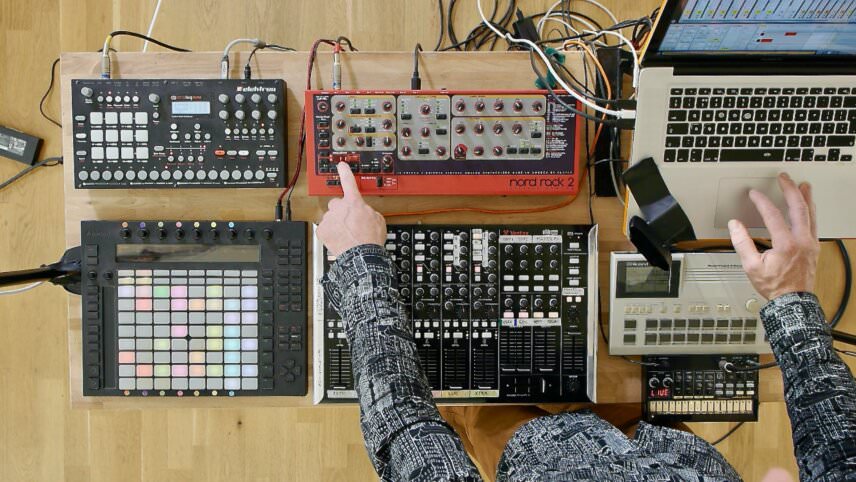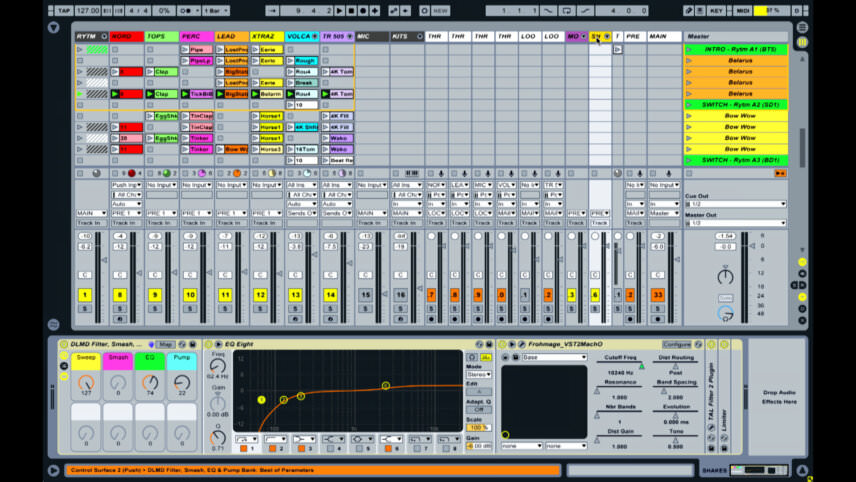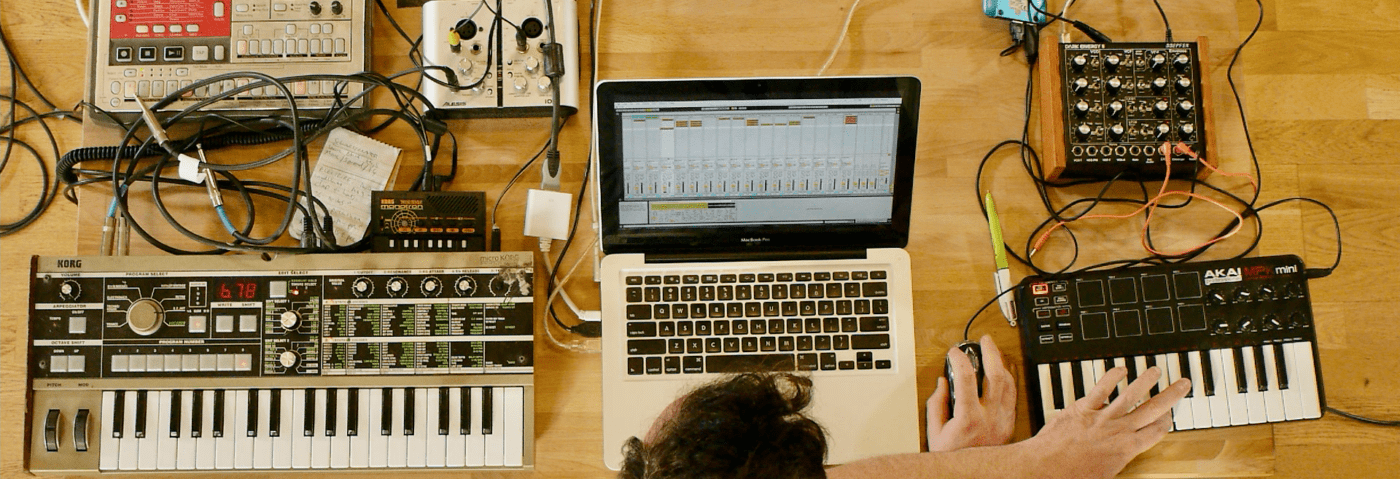With a whole world of competition online, how does MusicGurus Creative Sampling & Creative Composition hold up? Jonny Strinati goes back to school to find out.
Overview
MusicGurus is an online music learning platform taught by professional musicians and producers. The site features a wide range of content, from singing lessons to guides on publishing and synchronisation right through to music production tutorials geared towards electronic musicians.
The 2 courses we’re looking at are ‘Creative sampling & production in Ableton Live’ and ‘Creative composition & production in Ableton Live’ have been put together by tutor John Watson. Producing under the Jonathan Krisp guise, John has also worked with Depeche Mode, Cure Producer Dave Allen and Patrick Wolf. In addition to this, he’s a sound engineer who also writes music for TV and film. Essentially, you’re confident the tutor has plenty of real-world experience and knowledge to impart.
Each course has been split into 14 videos, covering around 2 hours each. Bar one or two of the videos, they’re mostly around 5-7 minutes in length, making it very easy to digest the information. The video editing provides some nice variation too. Switching between the Ableton screencast, the overhead shot and the front shot, you can effectively gauge how the controllers and hardware are being integrated with the software, whilst at the same time maintaining the sense you’re in a classroom and learning environment.
You’re also able to download all the files (Ableton Project plus samples) used in these courses. Only Ableton’s native plugins are utilised in the production, so as long as you have a copy of Ableton Live, the exact same teaching project will load up stress-free. No pesky missing plugins!
The equipment used in these tutorials (along with a laptop and Ableton Live) include the Korg Electribe Drum Machine, Korg Microkorg and Doepfer Dark Energy Synth, amongst a few other bits and pieces. These are all fairly affordable pieces of kit, and you’d presume many even with the most modest of studio set-up’s would have something of a similar ilk. The point here is to emphasise being creative with what you’ve got. A portable and attainable set up, which along with a DAW, such as Ableton Live in this walkthrough, is all you need to create amazing music.
Creative Sampling & Production in Ableton Live
The first few videos in this course cover the equipment and the way it’s set up and the preparation of samples and audio. Also, seeing as the course is primarily concerned with sampling, John is clear to point out how you may infringe on copyright material. For example, using a full bass loop you’ve sampled and dropped straight into your track is illegal, however, isolating a bass one shot from the loop and using this to create a new melody should alleviate any such issues.
There are some great pointers, not only with regards to creative sampling but also to starting tracks in general. That sometimes daunting prospect of beginning a new project can be quickly negated when you’re able to pull in some samples to provide inspiration and kick start a new idea.
However, if you want to approach music-making in this way, it’s paramount you have some compelling and unique samples to start with! Of course, you can import live sampled elements from anywhere, including Ableton’s factory bank or other sample packs. Although, as John points out in this course, you’re more likely to create something distinctive and original using unique sampled elements that you’ve collected from various and obscure sources.
The point here is to emphasise being creative with what you’ve got..
John employs a live recording he made of someone playing the steel drum in a park as the main melody for the track. He has also sampled rare vinyl’s he’s bought from charity shops and goes on to record in some rhythmic grooves from his Electribe that he manipulates on the fly with the Korg Monotron. This results in a varied palette of interesting sounds from which he constructs the track.
Another point to mention is John uses a tuned piano sample to get his samples in key, though newcomers without any music theory knowledge may not have the ear for this. So it’s worth pointing out that Ableton does feature a tuner plugin, allowing you to tune your samples without relying on your ear, should you not trust it!
The technique he uses for bringing in samples such as the hang drum loop and warping it to tempo whilst keeping the natural groove and live feel is great. Also, the techniques for transposing one-shots and loops, provides insight not only for moulding sounds to fit your project but also for adding some of your own flavours. You’re definitely encouraged here to experiment with samples in order to imbue your own vibe and style.
Watching through a course such as this one, where you can see a track being created in front of you, with every step being discussed, not only provides you with some excellent ideas for creative sampling but also for music production in general. Explaining some background detail on how to search for and find complementing sounds, find and create contrast between elements, and begin building a cohesive arrangement … these are all essential and fundamental steps in the music production process.
It’s a very organic angle that’s utilised, mostly instrument samples, truncated in Simpler and then played live. It hammers home the approach for adding elements in this way, feeling out the groove of each sound by triggering it on the keyboard whilst moulding the characteristics in Sampler, and then simply hitting record!
The inclusion of sampling drum machines and synthesisers is also a welcome addition with some useful workflows if you’re unsure about how to record hardware into Ableton. And then how to begin editing the captured audio in the sampler. The focus is very much on working with audio in this course, hence even in this section the hardware isn’t tweaked very much, rather ‘committed’ into Live for further manipulation.

The course goes on to suggest ideas for sketching out your arrangement, working in session view in Ableton to build up and experiment with different scenes and then begin creating a structure. Again, the ‘live’ feel is extended here with the initial sketch of the track being recorded on the fly into the arrangement view. Simplifying the arrangement process into something more natural and improvised can then be fine-tuned and tweaked to give everything a more cohesive flow.
John moves on to the mixing stage. Not delving too deep with complex processing chains, or instantly reaching for a series of effects, his technique is very much less is more. Balancing the sounds and gelling everything without too much emphasis on heavy sound design or extreme production techniques. A nice reminder that sometimes a simple bit of EQ and compression is all you need!
Attack Readers also get 15% up till 30th September! Just use discount code: MGATTACK15 at checkout on the MusicGurus website.
Creative Composition & Production in Ableton Live
This course is geared towards generating inspirational musical ideas, covering how to record, edit and arrange them, with the intention once again of helping you to write fully-fledged productions. Beginning with an empty Ableton template and going all the way through to the final mixdown session.
As with the Creative Sampling course, this has been rated at an Intermediate level, though many of the techniques used, especially using Ableton and the software, would be no trouble for a beginner to follow along.
The course kicks off with some good info on setting up MIDI inputs for triggering devices and effectively getting audio into Live. All of this is recorded into Ableton via the Alesis iO2 Soundcard.

John’s tuition style again is very clear and concise. Everything is explained in a very straightforward manner, with topics broken down into an intuitive language.
For example, before recording any MIDI, he takes the time to explain what MIDI is, rather than presuming the viewer is already familiar with this topic.
It’s a nice approach to tuition, working through and building up a track from scratch, rather than watching a producer discuss and walkthrough something that’s already been made. The potential pitfalls and stumbling blocks you’ll inevitably encounter in generating ideas are dealt with and addressed. Such as groove issues, finding complementing sounds and when and how to identify when elements are (and aren’t) working well together.
Using the Schwarzonator to spark inspiration is another excellent walkthrough. Shwarzonator is a Max For Live Device created by Henrik Schwarz, that helps you create chords and melodies. As John points out, an excellent plug in to turn to in order to spark inspiration especially if you’re not so strong with musicianship.
The potential pitfalls and stumbling blocks you’ll inevitably encounter in generating ideas are dealt with and addressed.
In this course, you’re encouraged to think about arrangement and track structure as you’re creating your elements. Even in the ‘loop stage’ John suggests the viewer should think about creating longer loops with movement and subtle timbre changes. So as soon as you begin recording parts into your track you’re already working with a 16/32 bar piece with lots of dynamics. Potentially making the creation of a compelling arrangement that little bit more fluid.
Once all the parts are assembled, the course takes a similar path to the Creative Sampling course regarding sketching out a structure and then mixing everything together.
Summary
As with all courses I’ve viewed on MusicGurus, the presentation and editing of the videos here are very professional. Switching between the Ableton screencast, a bird’s eye view of John’s studio set up and a front camera, to emphasise relevant sections of the tutorial it’s easy and engaging to follow.
£35 would seem good value for each course, considering the included course content and downloadable files. Although having watched through both of these courses, there is a fair amount of similar material covered in each with regards to the arrangement and mixing process. Having said that, it would be hard to avoid considering the approach to creating these tutorials, as both build and arranging and tracks from scratch, the techniques and workflows will inevitably cover some similar ground. No harm in drilling the fundamentals in!
One frustration is that I couldn’t find a way to watch the video content offline or download the videos themselves. This would make a welcome future feature.
Although more seasoned learners will find plenty of useful stuff here, it’s nice to know beginners are catered for too. Throughout the videos, there is a consideration that the viewer may not be familiar with certain terms or processes, often confusing topics are broken down into very simple language that should be easy to absorb.
To purchase Creative Composition & Production in Ableton Live or Creative Sampling & Production in Ableton Live visit the MusicGurus website.
Attack Readers also get 15% up till 30th September! Just use discount code: MGATTACK15 at checkout on the MusicGurus website.
